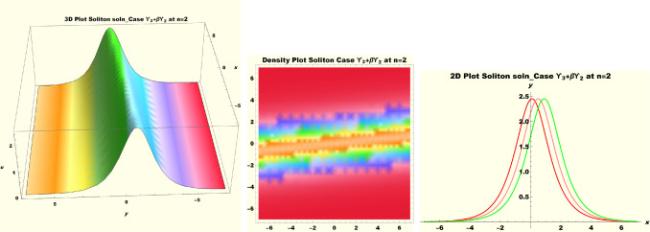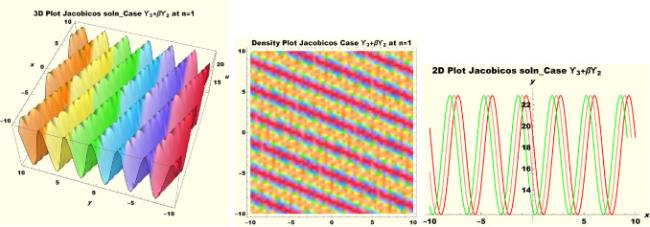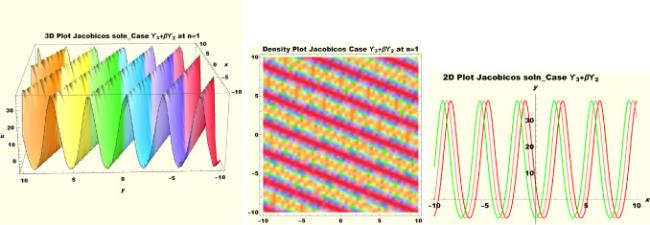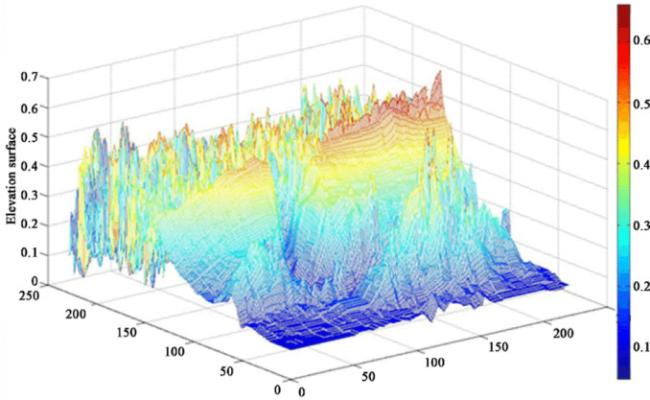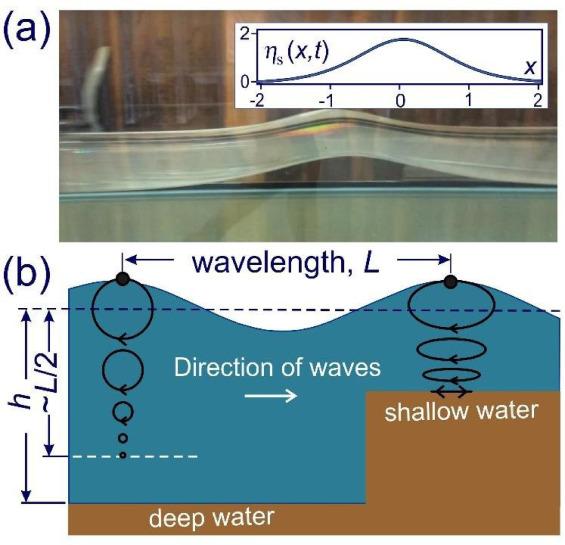Physical interpretations of various solitary wave solutions secured in this study are presented in this section in order to reveal their physical meaning. Thus, we depict these solutions via 3-D plot, 2-D plot as well as density plots. In order to exhibit the most advantageous representation of the graph, we make appropriate arbitrary choice of constants. The dynamical character of soliton solution (3.21) is portrayed in Fig. 1, using the suitable constant parameters , , , , , , , when at with . In addition, Fig. 2 is plotted with the aid of assigned values , , , , , , , when with the same value of and intervals. Soliton (3.29) is represented in Fig. 3 by invoking the parametric values , , , , , , , with , variables and . Fig. 4 further reveals the streaming behaviour of (3.29) through dissimilar constant values , , , , , , , , when , and . Next, multi-soliton structure in Fig. 5 portrays the soliton solution (3.30) via unalike parameters , , , , , , , , where , with in the interval . Moreover, we plot Fig. 6 to exhibit the solution by assigning suitable constant values , , , , , , , , when , and . The Figure reveals another multi-soliton wave of the solution. The compacton-type soliton wave structure in Fig. 7 is plotted through the numerical simulation of bright soliton (3.33) with parameters , , , , , , , , when , as well as . In the same vein, bell-shaped Fig. 8 further depicts the solution with constant values , , , , , , , , when , and . The combo-type solitons which is an interesting wave structure in physical sciences exhibited in Fig. 9 portrays the singular soliton solution (3.34). This is achieved via the dissimilar constant values , , , , , , , , when with and variables existing in the interval . Besides, the motion of the solution is further simulated numerically yielding Fig. 10 with parameters , , , , , , , , where with variable assuming the same value and , the same range of interval. Next, we examine the dynamics of soliton waves of periodic soliton solution (4.43) in Fig. 11 with values , , , , , , , , where and . Solitary wave solution (4.44) in Fig. 12 with values , , , , , , , , where and variables . In the same vein numerical simulation of soliton (4.48) in Fig. 13 with values , , , , , , , where we have and variables . Moreover, Fig. 14 depict the motion of soliton (4.49) with values , , , , , , , where variables and . The snoidal wave solution (4.53) is represented with Fig. 15 using unalike parameters , , , , , , , , where and . Numerical simulation of solitary wave solution (4.54) is depicted with Fig. 16 by invoking parameters , , , , , , , , where and . Snoidal wave solution (4.58) is portrayed via Fig. 17 using parametric values , , , , , , , where and . Further to that, Fig. 18 represents the dynamics of solution (4.59) through dissimilar parameters , , , , , , , , where and . Fig. 19 portrays the wave motion of cnoidal wave solution (4.64) where the graphs in the Figure are plotted using the constant parameters , , , , , , , with as well as . In the same format, we have solution (4.65) depicted in Fig. 20
whereas on the -plane, . Next, we examine the wave dynamics of snoidal wave solutions. Thus, solution (4.76) is represented via Fig. 24 with parametric values , , , , , , , with as well as . Besides, we plot solution (4.77) in Fig. 25 by assigning , , , , , , , with alongside . Solution (4.78) is depicted in Fig. 26 through the dissimilar constant values , , , , , , , whereas assumes the same value and , the same range. Periodic soliton (4.83) is plotted in Fig. 27 with , , , , , , with
where solution (4.84) is portrayed in Fig. 28 using , , , , , variable and . We reveal the dynamics of snoidal wave solution (4.85) in Fig. 29 through , , , , , , whereas together with . Furthermore, cnoidal wave solution (4.91) is depicted in Fig. 30 via constants , , , , , , , , with alongside . In the same vein, periodic solution (4.91) is plotted in Fig. 31 through variant parametric values , , , , , , , , where we have as well as . In Fig. 32, we represent cnoidal wave (4.91) via constant values , , , , , , , , where and . Besides, solitary wave solution (4.92) is furnished in Fig. 33 using , , , , , , , , with alongside . Solitary wave solution (4.99) is represented in Fig. 34 by utilizing parameters , , , , , whereas together with . In addition to that cnoidal wave (4.100) is exhibited in Fig. 35 by invoking parametric values , , , , , , where alongside . We depict periodic soliton (4.101) in Fig. 36 via the use of , , , , , , whereas and . Furthermore, solitary wave solution (4.107) is purveyed in Fig. 37 with dissimilar constants , , , , , , , , where we have along with . Periodic solution (4.108) is exhibited in Fig. 38 with unalike constants , , , , , , , , with variables together with on the -plane. The snoidal wave (4.109) plotted in Fig. 39 is achieved via choice of constants , , , , , , , , whereas variable alongside .
Moreover, dynamics of snoidal wave (4.110) is numerically simulated thereby purveying Fig. 40 by engaging most beneficial parametric constant values , , , , , , , , whereas we have variable and also . Fig. 41 depicts smooth periodic solution (4.115) using , , , , , , , with variable and on the -plane. In the same vein, smooth snoidal wave (4.116) is portrayed in Fig. 42 with dissimilar constant values , , , , , where and . Finally, we simulate periodic soliton (4.117) numerically via , , , , , , where we assign variable and on the -plane.



